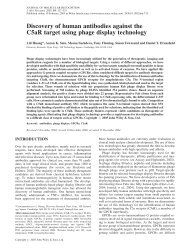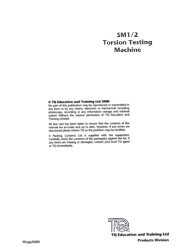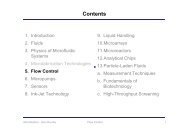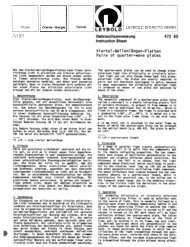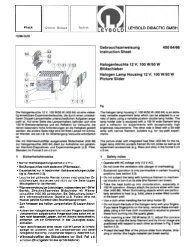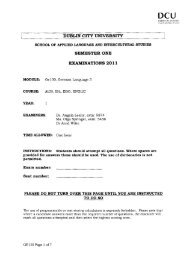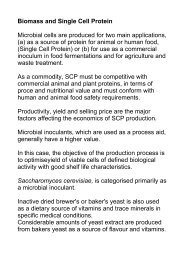Penicillin Production - DCU
Penicillin Production - DCU
Penicillin Production - DCU
Create successful ePaper yourself
Turn your PDF publications into a flip-book with our unique Google optimized e-Paper software.
vital component of aerobic metabolism, it is essential that there is good transfer of<br />
oxygen across the gas/liquid interface. The Sparger delivers this oxygen. One problem<br />
with gas/liquid interfaces is the formation of foam. The impeller that serves to break<br />
up the foam generally relieves this.<br />
Heat Transfer is important because metabolism as a process tends to give off heat, as<br />
does the mechanical mixing by the impellers. If the reactor needs to be operated at a<br />
constant temperature of range of temperatures, then it is critical that there is some<br />
kind of system to cool the reactor. This is normally achieved through a combination<br />
of a cooling jacket and cool water being passed around the tank.<br />
Bulk Flow and Mixing are achieved by the impellers. Most reactors use the Rushton<br />
Flat-bladed disc turbine seen in the diagram. Fluid flow in a reactor can be described<br />
as Newtonian or non-Newtonian. Newtonian fluids show constant viscosity and linear<br />
shear rate against shear stress. However many fluids are non-Newtonian and are<br />
described as Bingham or Pseudoplastic.<br />
Batch, Fed-Batch and Continuous Culture are terms used to describe how nutrients<br />
and substrate will be delivered to a culture in a reactor. Batch simply means that a<br />
fixed amount of substrate is added at the beginning of the process. Fed Batch means<br />
that substrate is added in small increments at various times in the fermentation.<br />
Continuous means that substrate is constantly added to the reactor while an equal<br />
amount of fermented medium is removed.<br />
Steam is used to keep the reactor running aseptically. This is achieved because the<br />
reactor is designed as a pressure vessel and steam is sent through at a minimum<br />
temperature/pressure of 121 0 C/15 psi for 15-30min.<br />
So much for our discussion of basic reactor design. What follows is a brief description<br />
of the specific fermentation conditions necessary for the production of penicillin.<br />
Special fermenter Conditions for the production of <strong>Penicillin</strong><br />
Aside from what is described above, there are a few specific characteristics of<br />
penicillin that must be considered when attempting fermentation:<br />
• Most penicillins form filamentous broths that are pseudoplastic (non-<br />
Newtonian) in nature. This means they can be difficult to mix due to their high<br />
(and not constant) viscosity. Also the increasing viscosity of the broth can<br />
hinder oxygen transfer. Which leads to the next point.<br />
• <strong>Penicillin</strong> is an aerobic organism; therefore the rate of oxygen supply is critical<br />
to the fermentation. Thus, the reactor must have an efficient oxygen supply<br />
system.<br />
7






